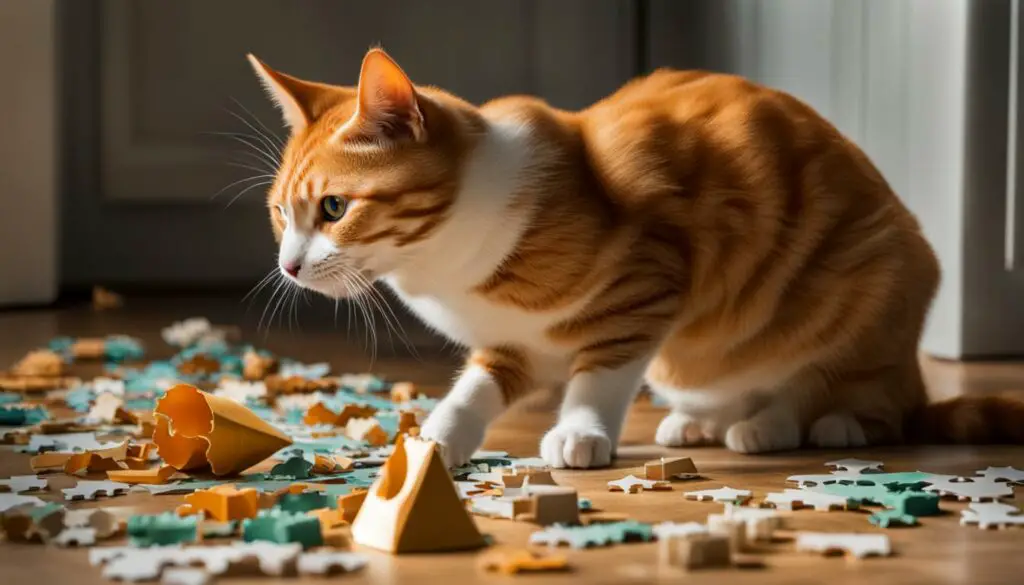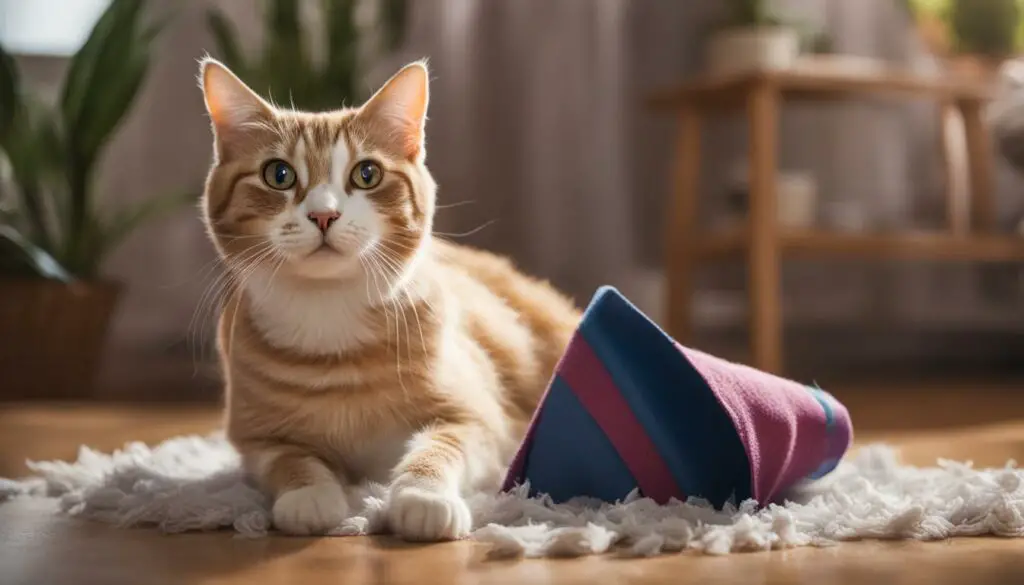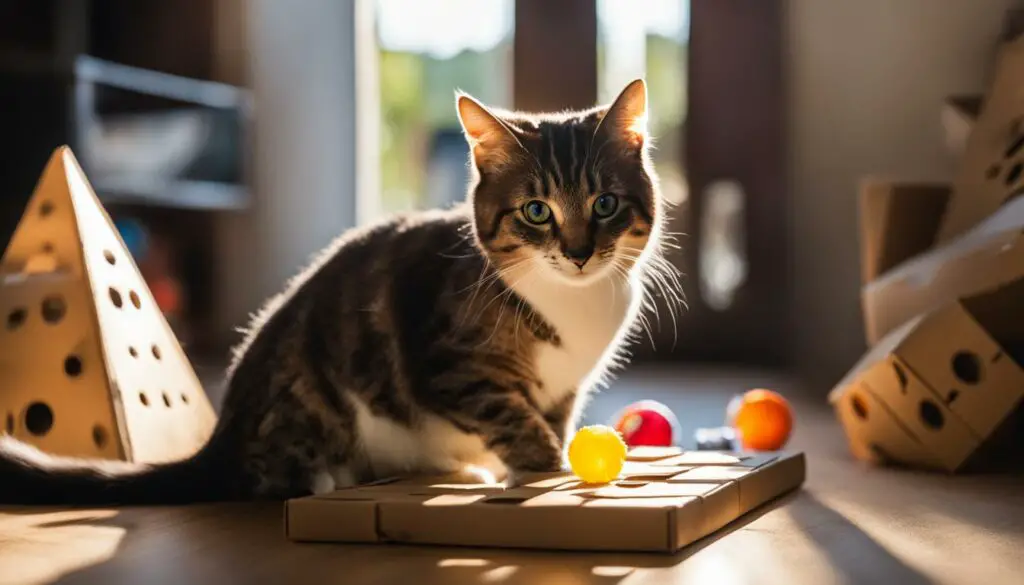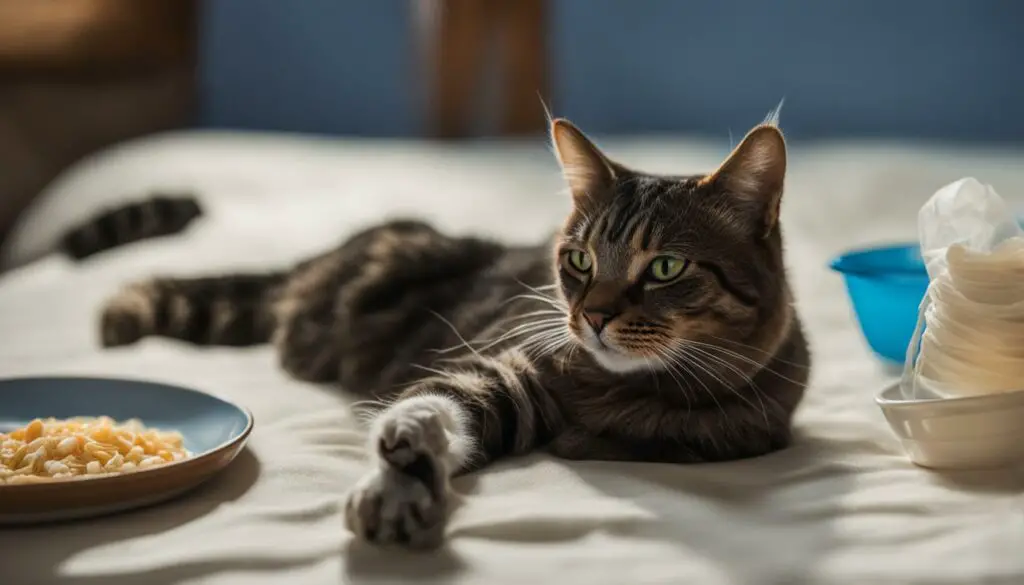As a pet owner, I understand how frustrating it can be when your cat refuses to keep their cone on after being spayed. It’s important to address this issue because the cone plays a crucial role in preventing your cat from licking or scratching the surgical site, aiding in a smooth recovery. In this article, I will share practical solutions and helpful tips to help you ensure that your furry friend keeps their cone on during the post-spay period.
Key Takeaways:
- Understanding why cats struggle to keep cones on
- Exploring alternative cone options
- Tips for easing discomfort during the recovery period
- Finding the right fit for the cone
- Keeping cats busy with distraction techniques
Understanding the Issue: Why Cats Struggle to Keep Cones On
After a spay surgery, cats may exhibit behaviors that make it challenging for them to keep their cones on. Understanding the reasons behind these struggles can help pet owners find effective solutions to ensure their cats‘ well-being during the recovery period.
One reason why cats struggle with cones is because they may feel uncomfortable or restricted by the cone itself. This discomfort can lead them to paw at the cone or try to slip out of it. Additionally, some cats may engage in increased grooming behavior, which can result in attempts to remove the cone. These behaviors are normal reactions to the unfamiliar device and the healing process.
It’s important to address these challenges with alternative solutions that prioritize the cat’s comfort and safety. By exploring alternative cone options or other protective barriers like inflatable collars or soft e-collars, pet owners can find options that provide a more comfortable fit for their cats while still preventing them from interfering with their surgical sites. Additionally, providing pain medication as prescribed by the veterinarian can help alleviate any discomfort the cat may experience.
Remember, cats may need some time to adjust to wearing a cone, and patience is key. Providing a calm and quiet environment, engaging the cat with distraction techniques or mental stimulation, and closely monitoring their behavior can all contribute to a successful recovery. Consulting with a veterinarian for guidance and support throughout the process is also highly recommended.

| Common Reasons Cats Struggle with Cones | Suggestions to Address the Issue |
|---|---|
| Discomfort or feeling restricted by the cone | Explore alternative cone options like inflatable collars or soft e-collars |
| Increased grooming behavior | Provide distraction techniques or mental stimulation |
| Attempting to paw at or remove the cone | Ensure a proper fit and monitor the cat’s behavior closely |
Alternatives to Cones: Finding the Right Solution
When it comes to keeping cats from interfering with their surgical sites after spay surgery, traditional cones may not always be the best solution. Luckily, there are alternative options available that can provide comfort and effectiveness. Let’s explore some cat cone alternatives that can help ensure a smooth recovery for your feline friend.
Inflatable Collars
One popular alternative to traditional cones is inflatable collars. These collars are sold at pet stores and are designed to provide a more comfortable fit for cats, especially smaller breeds. The inflatable design allows for flexibility while still preventing the cat from reaching their surgical site. It’s important to ensure that the collar is properly inflated and fits snugly around the cat’s neck to ensure its effectiveness.
Soft E-Collars
Another option to consider is soft e-collars. These collars are made from flexible material that is more comfortable for the cat to wear. They still provide a barrier to prevent licking or scratching, but they are less restrictive and may be more tolerated by some cats. Soft e-collars are available in various sizes and can be a good option for cats who struggle with traditional cones.
DIY Solutions
If you’re looking for a cost-effective alternative, there are DIY options that can provide a protective barrier for your cat. You can try using a sock or a bandage to create a makeshift cone that fits around your cat’s neck. This can be a good option for cats who are sensitive to the harder material of traditional cones. Just make sure that the DIY solution is secure and doesn’t pose any safety risks to your cat.
When exploring alternative cone options, it’s important to prioritize your cat’s comfort and safety. Each cat is unique, so it may take some trial and error to find the right solution. Consult with your veterinarian for guidance on selecting the best alternative cone for your cat’s specific needs. Remember, the goal is to ensure your cat’s well-being and promote a smooth recovery after spay surgery.

Ensuring Comfort: Tips for Easing Discomfort
During the recovery period after a cat’s spay surgery, it is important to prioritize their comfort and well-being. Here are some helpful tips to ease any discomfort they may experience:
- Provide pain medication as prescribed by the veterinarian: Pain management is crucial in ensuring the cat’s comfort during the recovery period. Administer any prescribed pain medication according to the veterinarian’s instructions to help alleviate any discomfort the cat may be experiencing.
- Create a calm and quiet environment: Cats may feel stressed or anxious after surgery, so it is important to create a peaceful space for them to recover. Keep loud noises to a minimum and provide a comfortable, cozy area for the cat to rest.
- Offer comfort measures: Help soothe the cat by providing soft bedding or blankets for them to snuggle into. Gentle petting and reassurance can also go a long way in providing comfort and support during this time.
Remember, each cat is unique, and their comfort needs may vary. Pay attention to their behavior and adjust your approach accordingly to ensure they feel safe and at ease during their recovery.

Testimonial from Cat Owner:
“My cat had a hard time keeping the cone on after her spay surgery. To help ease her discomfort, I made sure to provide a cozy recovery space with soft bedding. I also used a calming pheromone diffuser in the room to help reduce her anxiety. These measures made a significant difference in her overall comfort and helped her through the recovery period.”
By prioritizing the cat’s comfort and implementing these tips, you can ensure a smoother and more comfortable recovery after spay surgery.
Size Matters: Finding the Right Fit
When it comes to ensuring that a cat keeps its cone on after spay surgery, finding the right fit is crucial. If the cone is too large, the cat may be able to slip out of it or maneuver their paws through it. On the other hand, if the cone is too small, it may cause discomfort and restrict the cat’s movement. Consulting with the veterinarian or exploring alternative cone options can help find the perfect fit for your cat’s size and comfort.
One method to determine the proper cone size is by measuring your cat’s neck circumference. Using a soft measuring tape or a piece of string, wrap it around the widest part of your cat’s neck and then measure the string or tape. This measurement will give you an idea of the appropriate cone size to look for. It’s important to note that each cat is unique, so finding the right fit may require some trial and error.
In addition to size, consider the design of the cone. Some cats may prefer a more open cone design that doesn’t obstruct their vision or make them feel too confined. Others may prefer a cone with extra padding for added comfort. Exploring different cone options, such as those made from flexible materials or inflatable collars, can help ensure that your cat is comfortable while still preventing them from removing the cone.
| Factors to Consider | Importance |
|---|---|
| Proper size | Essential |
| Comfortable design | Crucial |
| Alternative options | Helpful |
| Open cone design | Preferred by some cats |
| Extra padding | Enhanced comfort |
“Finding the right fit for the cone is important to ensure that your cat’s recovery is as smooth and comfortable as possible. Taking the time to measure your cat’s neck circumference and exploring different cone designs can make a significant difference in your cat’s willingness to keep the cone on.”
Choosing the Right Cone Alternative
If your cat absolutely refuses to wear a traditional cone, there are alternative options you can consider. One popular alternative is inflatable collars. These collars provide a more comfortable fit for smaller cats and still prevent them from accessing the surgical site. Soft e-collars made from flexible materials can also be a viable option, as they allow for greater freedom of movement while still providing protection. Additionally, you can try creating a DIY cone alternative using a sock or a bandage to create a protective barrier around the surgical site. It’s important to evaluate your cat’s comfort and safety when exploring cone alternatives and consult with your veterinarian if needed.
Distraction Techniques: Keeping Cats Busy
During the recovery period after spaying, cats may become restless and agitated, making it challenging for them to keep their cones on. To alleviate their discomfort and prevent them from focusing on removing the cone, distraction techniques can be highly effective. Engaging the cat’s mind and providing mental stimulation can redirect their attention and help them cope with wearing the cone.
One way to keep cats busy is by providing puzzle toys or interactive games. These toys can engage their curiosity and provide a source of entertainment while they recover. Placing treats or small toys inside the puzzles can further increase their interest and keep them engaged for longer periods of time.
Another option is to offer long-lasting chews or lick mats. These can provide a soothing and distracting activity for the cat. Lick mats, in particular, can be filled with tasty treats or wet food, encouraging the cat to focus on licking rather than trying to remove the cone.

Quote: A Distraction Success Story
“I found that teaching my cat new tricks during her recovery period was a great way to keep her mentally stimulated and distracted from removing her cone. We started simple with high fives and gradually progressed to more complex commands. Not only did it keep her busy, but it also strengthened our bond!” – Cat owner, Sarah
Engaging in training sessions and teaching new tricks can not only keep the cat mentally stimulated but also strengthen the bond between the cat and their owner. This interaction and positive reinforcement can help distract the cat from the discomfort of wearing the cone.
By implementing these distraction techniques, cat owners can provide their furry friends with a means of staying occupied and entertained during the recovery period. Remember to consider the cat’s preferences and adjust the distractions accordingly. Consulting with the veterinarian for additional suggestions and guidance can also be beneficial in ensuring the cat’s post-spay care is optimized.
| Distraction Techniques for Cats | Description |
|---|---|
| Puzzle Toys | Provide interactive toys that engage the cat’s curiosity and require problem-solving skills. Place treats or small toys inside to increase interest. |
| Long-lasting Chews | Offer chews or bones that can keep the cat occupied for an extended period of time. |
| Lick Mats | Fill a lick mat with tasty treats or wet food to distract the cat and encourage licking instead of removing the cone. |
| Training Sessions | Engage the cat in training sessions and teach them new tricks to provide mental stimulation and strengthen the bond between cat and owner. |
Supervision and Monitoring: Ensuring Safety
When it comes to preventing a cat from removing its cone after spay surgery, close supervision and monitoring are crucial. By keeping a watchful eye on the cat’s behavior, we can identify any attempts to remove the cone or signs of discomfort. This allows us to intervene promptly and ensure the cat’s well-being during the recovery period.
In order to effectively supervise and monitor the cat, it is important to limit their access to certain areas that may pose a risk to their healing process. Using baby gates or closing doors can prevent the cat from engaging in activities that could interfere with their recovery. By creating a safe, controlled environment, we can minimize the chances of the cat tampering with their cone and potentially causing harm to themselves.
Key Takeaways:
- Close supervision and monitoring are essential to ensure the cat’s safety during the recovery period after spay surgery.
- By keeping a watchful eye, we can identify any attempts to remove the cone or signs of discomfort.
- Limiting the cat’s access to certain areas and using baby gates can prevent them from engaging in activities that may interfere with their healing process.
Regular check-ins with the veterinarian are also important during this time. They can provide guidance on how to best monitor the cat’s progress and offer support if any concerns arise. The veterinarian may recommend additional pain management measures or behavior modification techniques to ensure the cat’s safety and comfort.
Remember, the recovery period after spay surgery is crucial for the cat’s well-being. By actively supervising and monitoring their behavior, we can help prevent them from removing their cone and facilitate a smooth and successful recovery.

Section 8: Recovery Space: Creating an Optimal Environment
Creating a dedicated recovery space for your cat is crucial to ensure a smooth healing process. By providing a quiet and comfortable area away from high-traffic zones and other pets, you can help reduce stress and promote relaxation. It’s important to remember that during the recovery period, your cat needs a calm environment to heal properly. Consider setting up a cozy corner in a spare room or a quiet area in your home where your cat can rest undisturbed.
Make sure to place essential items such as food, water, and litter within easy reach of your cat’s recovery space. This will prevent unnecessary movements like climbing stairs or jumping onto furniture, which could hinder the healing process. By keeping everything conveniently close, you can minimize any additional stress that may arise from your cat’s restricted mobility.
| Item | Placement |
|---|---|
| Food | In a shallow dish near your cat’s resting area |
| Water | In a spill-proof bowl within easy reach |
| Litter box | Close to the resting area, ensuring easy access |
In addition to the basic necessities, you can enhance the recovery space by incorporating soft bedding, such as a cozy blanket or a plush mat, to provide extra comfort and warmth for your cat. Creating a soothing environment with calming scents, like lavender or chamomile, can also contribute to a more relaxed atmosphere.
Ultimately, the goal is to create a space where your cat feels safe, secure, and at ease during the recovery period. By taking these steps, you can ensure that your furry friend has an optimal environment to heal and recover from their spay surgery.
Resources
- Bringing Home Your Newly Spayed Cat: Post-Spay Care Tips – Catster
- How to Care for Your Cat After Neutering or Spaying – The Spruce Pets
- Creating a Comfortable Space for Your Spayed Cat – Purina
Seeking Professional Guidance: Consulting with the Veterinarian
When facing challenges with a cat refusing to keep the cone on after spay surgery, it is important to seek professional guidance from a veterinarian. Consulting with a veterinarian can provide valuable insights and solutions to ensure the cat’s safety and comfort during the recovery period.
The veterinarian can assess the cat’s incision site and determine if there are any underlying issues that may be causing discomfort or irritation. They may also recommend alternative cone options that are better suited for the cat’s size and behavior. Additionally, the veterinarian can provide additional pain management techniques if necessary, ensuring the cat’s recovery is as smooth as possible.
With their expert knowledge and experience, veterinarians can also provide guidance on behavior modification techniques to address any attempts to remove the cone. This may include suggestions for distraction techniques or training methods to redirect the cat’s focus and keep them occupied during the recovery period. Continual communication with the veterinarian throughout the recovery process can help address any concerns or questions that may arise.
Remember, the health and well-being of your cat are of utmost importance, and seeking professional guidance from a veterinarian is a crucial step in ensuring a successful spay recovery. By working together with your veterinarian, you can find the best solutions to prevent your cat from removing the cone and help them recover comfortably.
Cat Owners Share Their Experiences
As a cat owner, I understand the challenges of keeping a cone on your feline friend after a spay surgery. To gain insights and advice from others who have gone through similar experiences, I reached out to fellow cat owners. Their stories and solutions offer valuable guidance for those struggling with the same issue.
“I tried various cone alternatives for my cat, and the inflatable collar worked wonders! It provided a comfortable fit without restricting her movement too much.”
– Sarah, cat owner
Many cat owners have found success with inflatable collars as an alternative to traditional cones. These collars are available in pet stores and can provide a more comfortable fit for cats of all sizes. The flexibility of the collar allows cats to move around more freely while still preventing them from accessing their surgical site.
- Pro tip: Ensure the collar is properly inflated and securely fastened to prevent the cat from removing it.
- Pro tip: Introduce the collar gradually, allowing your cat to get used to wearing it for short periods before extending the duration.
Some cat owners have also found success with DIY solutions such as using a sock or a bandage to create a protective barrier around the surgical site. These homemade alternatives can be more comfortable for cats and may help alleviate their urge to remove the cone.
Expert Tip: Consult with a Veterinarian
Remember, every cat is different, and what works for one may not work for another. It’s always best to consult with a veterinarian to determine the most suitable option for your cat. They can assess your cat’s behavior, offer advice on alternative cone options, and provide guidance on behavior modification techniques if necessary. With their expertise and personalized recommendations, you’ll be able to find the most effective solution for your cat’s comfort and well-being during the spay recovery period.
| Cone Alternative | Pros | Cons |
|---|---|---|
| Inflatable Collar | Comfortable fit, allows freedom of movement | May not be suitable for cats with a strong determination to remove the collar |
| DIY Sock or Bandage | Customizable and more comfortable | May require more frequent adjustments or replacements |
Tips for Future Spay/Neuter Procedures
When preparing for future spay/neuter procedures, it’s important to take into consideration the challenges that may arise, such as a cat refusing to keep its cone on. To ensure a smooth recovery process, here are some helpful tips:
- Discuss cone-wearing challenges with the veterinarian: Before the surgery, have a conversation with your veterinarian about alternative cone options. They can provide guidance on finding the right fit for your cat and suggest behavior modification techniques to help your cat adjust to wearing the cone.
- Plan ahead and gather necessary supplies: Make sure you have all the necessary supplies ready before the surgery. This includes a properly fitting cone, pain medication prescribed by the veterinarian, and any alternative options you may have discussed.
- Create a dedicated recovery space: Set up a quiet and comfortable area for your cat to recover in. This should be away from high-traffic areas and other pets to minimize stress and provide a calm environment for healing.
- Monitor your cat closely: Keep a watchful eye on your cat’s behavior during the recovery period. Look for any signs of discomfort or attempts to remove the cone. If needed, limit their access to certain areas or use baby gates to prevent them from engaging in activities that may interfere with their healing process.
By implementing these tips and being proactive in your approach, you can help ensure a successful spay/neuter procedure and a smoother recovery for your cat.

Note: The image above is a visual representation of a cat in a recovery space. It is important to provide a dedicated area for your cat to recover in after the spay/neuter procedure.
Conclusion
Helping your cat keep its cone on after spay surgery is a common challenge for many pet owners. However, with patience and understanding, you can find practical solutions to ensure your furry friend’s comfort and wellbeing during the recovery period.
Exploring alternative cone options, such as inflatable collars or soft e-collars, can provide a more comfortable fit for your cat. Additionally, DIY solutions like using a sock or a bandage can create a protective barrier without compromising safety.
Remember to prioritize your cat’s comfort by providing pain medication as prescribed by the veterinarian and creating a calm and quiet recovery space. Engaging your cat with mental stimulation, such as puzzle toys and training sessions, can help distract them from trying to remove the cone.
If you continue to face challenges, don’t hesitate to consult with your veterinarian for guidance and support. They can assess the incision site, recommend additional pain management if needed, and provide further advice on behavior modification techniques to ensure a successful recovery.
FAQ
Why won’t my cat keep the cone on after spay surgery?
Cats may feel uncomfortable or restricted by wearing a cone and may try to remove it by pawing at it or finding ways to slip out of it. Increased grooming behavior can also lead to attempts to remove the cone.
What are some alternatives to traditional cones?
Alternative options include inflatable collars, soft e-collars made from flexible material, or DIY solutions such as using a sock or bandage to create a protective barrier.
How can I ensure my cat’s comfort during the recovery period?
Providing pain medication as prescribed by the veterinarian, creating a calm environment, offering cozy bedding and gentle petting can help alleviate discomfort and reduce anxiety.
How do I make sure the cone fits properly?
It is important to consult with the veterinarian or explore alternative cone options to find the right fit for your cat’s size and comfort.
How can I distract my cat from trying to remove the cone?
Providing puzzle toys, interactive games, long-lasting chews, or engaging in training sessions can help redirect your cat’s attention and keep them mentally stimulated.
How can I ensure my cat’s safety during the recovery period?
Supervision, monitoring their behavior, limiting access to certain areas, and regular check-ins with the veterinarian can help ensure your cat’s safety and a smooth recovery.
How can I create an optimal recovery space for my cat?
Providing a quiet and comfortable area, away from high-traffic areas or other pets, with essential items within easy reach can help reduce stress and promote relaxation.
What should I do if my cat consistently refuses to keep the cone on?
Consult with the veterinarian for assessment, additional pain management if necessary, and guidance on alternative cone options or behavior modification techniques.
Have other cat owners experienced similar challenges, and what solutions have they found?
Some cat owners have found success using inflatable collars or homemade alternatives such as socks or bandages. Hearing firsthand accounts from fellow cat owners can provide helpful insights.
How can I prepare for future spay/neuter procedures?
Discussing cone-wearing challenges with the veterinarian prior to surgery, exploring alternative options, and planning ahead with necessary supplies and information can make the process smoother.








